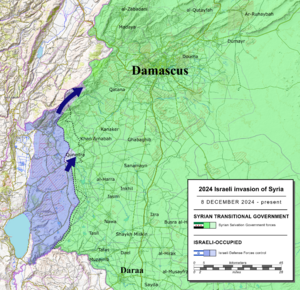2024 Israeli invasion of Syria facts for kids
Quick facts for kids 2024 Israeli invasion of SyriaOperation Arrow of Bashan |
|||||||
|---|---|---|---|---|---|---|---|
| Part of the Syrian civil war, Middle Eastern crisis, spillover of the Israel–Hamas war in Syria and Arab–Israeli conflict | |||||||
 |
|||||||
|
|||||||
| Belligerents | |||||||
| Commanders and leaders | |||||||
|
|||||||
| Units involved | |||||||
|
|
|||||||
| Strength | |||||||
| 2 brigades (6,000 – 10,000 troops) | Unknown | ||||||
| Casualties and losses | |||||||
| None | 6 Syrian civilians killed A number of Syrian civilians taken prisoner Material losses: Multiple military sites destroyed as well as ground, air and naval assets. |
||||||
On 8 December 2024, following the collapse of the Assad regime, Israel's armored units entered the United Nations Disengagement Observer Force (UNDOF) buffer zone between Syria and the Israeli-occupied Golan Heights. The operation, which involved artillery fire targeting the central countryside of Syria's Quneitra Governorate, marked the first Israeli occupation of the area in over 50 years, since the ceasefire agreements of 31 May 1974, which were established after the Yom Kippur War.
Israeli Prime Minister Benjamin Netanyahu declared that the Syrian Arab Army's abandonment of its positions had effectively voided the 1974 border agreement with Syria. In response, Netanyahu ordered the Israel Defense Forces (IDF) to temporarily take control of the Purple Line, a demilitarized zone from which Israeli forces had withdrawn in 1974, until a new agreement could be reached with the emerging Syrian government. Simultaneously, the Israeli Air Force and Navy launched extensive strikes on military targets across Syria under the operation named Operation Bashan Arrow (Hebrew: מבצע חץ הבשן, romanized: Mivtza Hetz HaBashan).
On 9 December, Israeli Defense Minister Israel Katz outlined specific military objectives for the IDF. These included the full occupation of the buffer zone and surrounding areas, the establishment of a security zone free from heavy weaponry and military infrastructure, and the prevention of Iranian arms smuggling routes through Syria to Lebanon.
Background
Since the Six-Day War in 1967, Israel has occupied most of the Golan Heights region of Syria. After the Yom Kippur War in 1973 Israel and Syria agreed on a Disengagement which left a No man's land between them, which was occupied by the UNDOF. In 1981, Israel unilaterally annexed the Heights, a move that has been condemned by the United Nations as illegal under international law and is unrecognized by every country in the world except for the United States, which recognized the Heights as part of Israel in 2019. Israeli officials lobbied for the United States to recognize Israeli sovereignty over the territory. During its occupation, Israel has actively promoted Israeli settlement in the Heights.
In November 2024, the United Nations accused Israel of violating the 1974 Disengagement Agreement in November with engineering work and battle tanks inside the demilitarized zone. UNDOF stated it had "repeatedly engaged with the IDF to protest the construction." Israel responded that it was “working to establish a barrier on Israeli territory exclusively in order to thwart a possible terrorist invasion and protect the security of Israel’s borders,” and noted that “Israeli and IDF officials maintain close contact with UN officials who are familiar with the threats in the region.”
In December 2024, the Syrian opposition launched a major offensive against the Syrian regime led by Bashar al-Assad. Following the fall of the Assad regime, Israeli Minister of Diaspora Affairs and Combating Antisemitism Amichai Chikli expressed apprehension at the opposition forces' political upheaval of the Syrian government, claiming that: "Most of Syria is now under the control of al-Qaeda and Daesh." He implored Israel to re-fortify its defensive line at Mount Hermon in Israeli-occupied Golan Heights based on 1974 borders in order to prevent potential attacks by the new regime.
Israeli plan
On 9 December, Israeli Defense Minister Israel Katz authorized concrete and comprehensive military objectives in southern Syria. The Israeli Defense Forces received four primary strategic objectives from Defense Minister Katz to conduct "in the immediate term":
- To secure complete control over the buffer zone and other nearby strategic positions in Syria.
- To establish a security zone extending beyond the buffer zone, focusing on removing all heavy weaponry and terrorist infrastructure that could post a threat to Israel, while establishing contact with local Druze communities and other regional communities.
- To immediately prevent the reestablishment of Iranian arms smuggling routes to Lebanon through Syrian territory and border crossings.
- To continue destroying strategic heavy weapons systems throughout Syria, including air defense networks, missile systems, and coastal defense installations.
See also
 In Spanish: Invasión israelí de Siria para niños
In Spanish: Invasión israelí de Siria para niños

